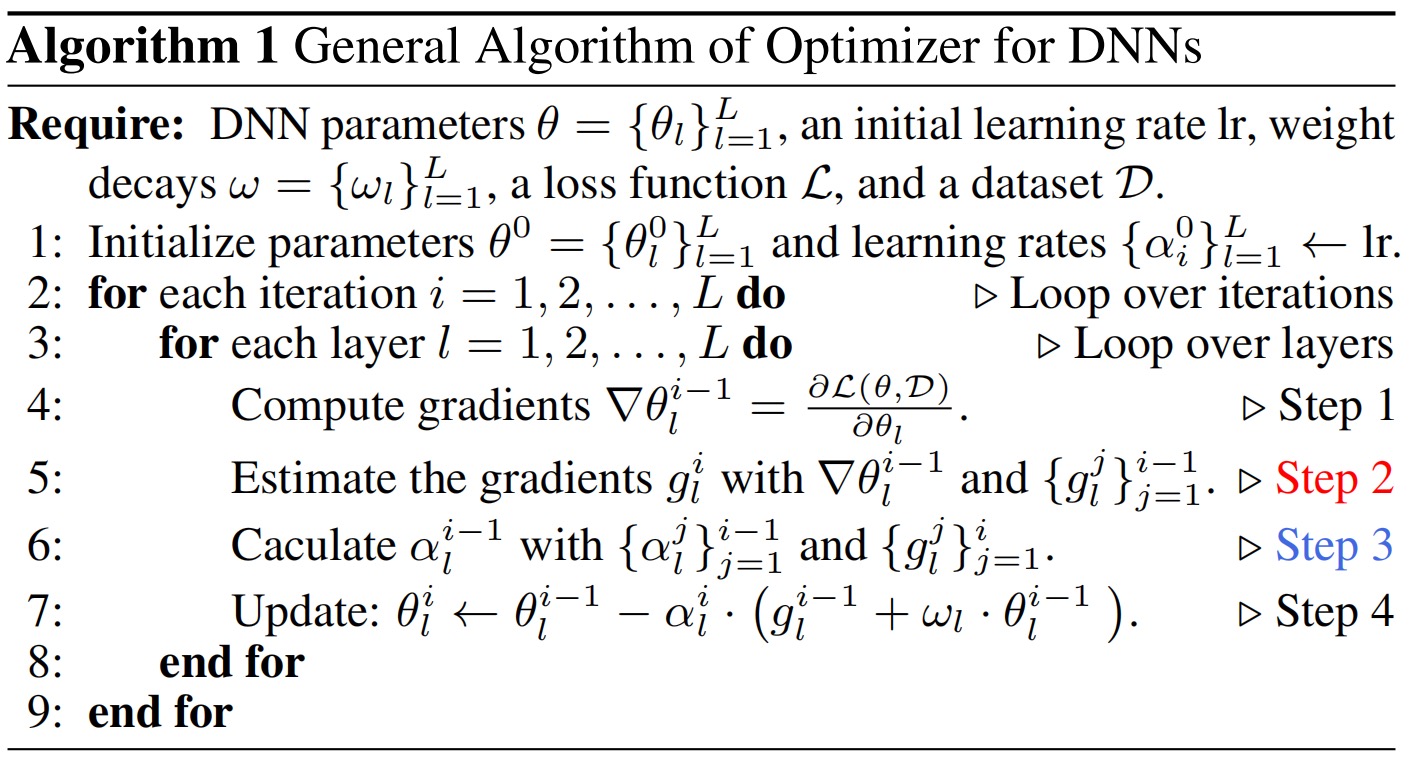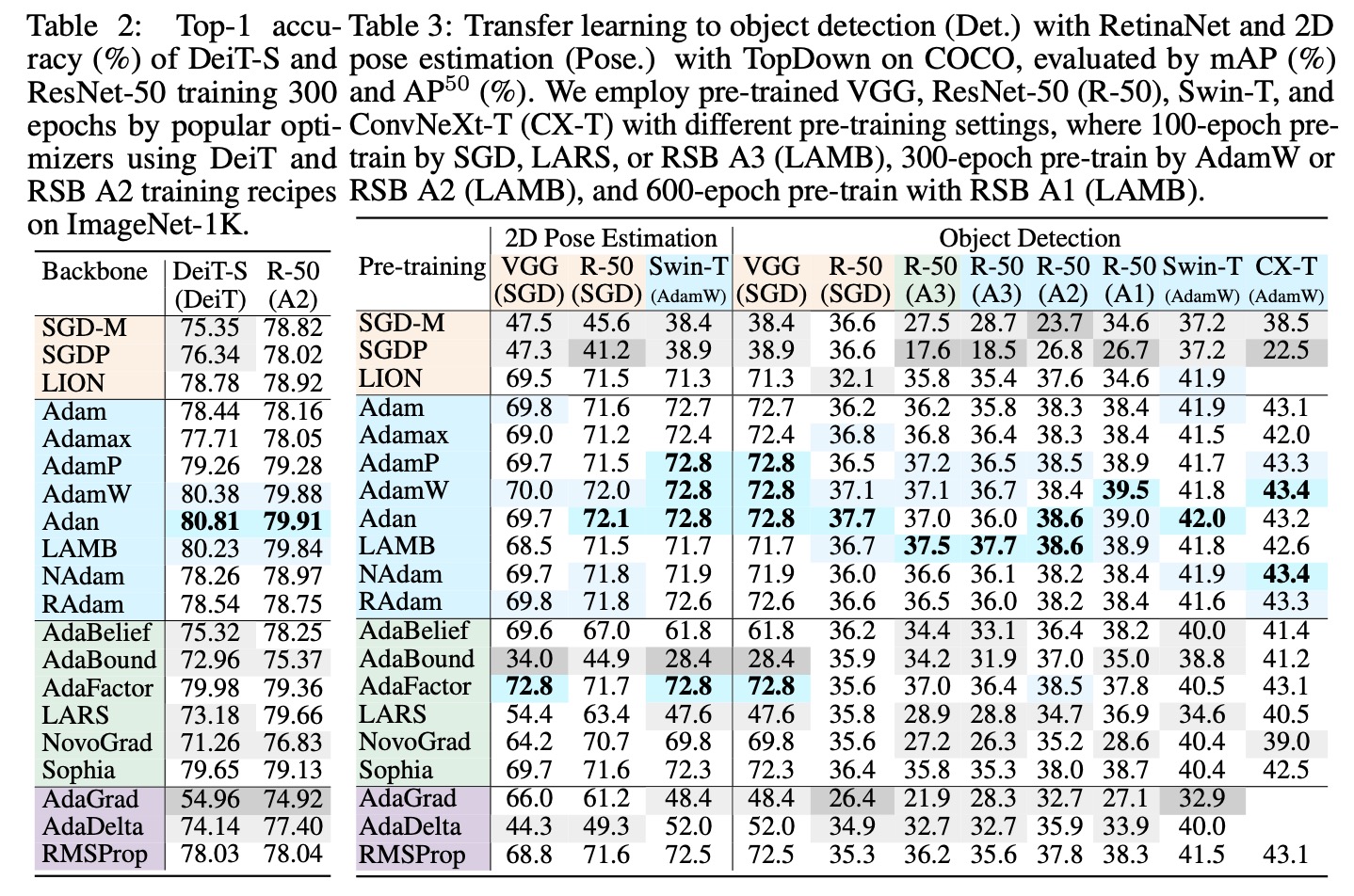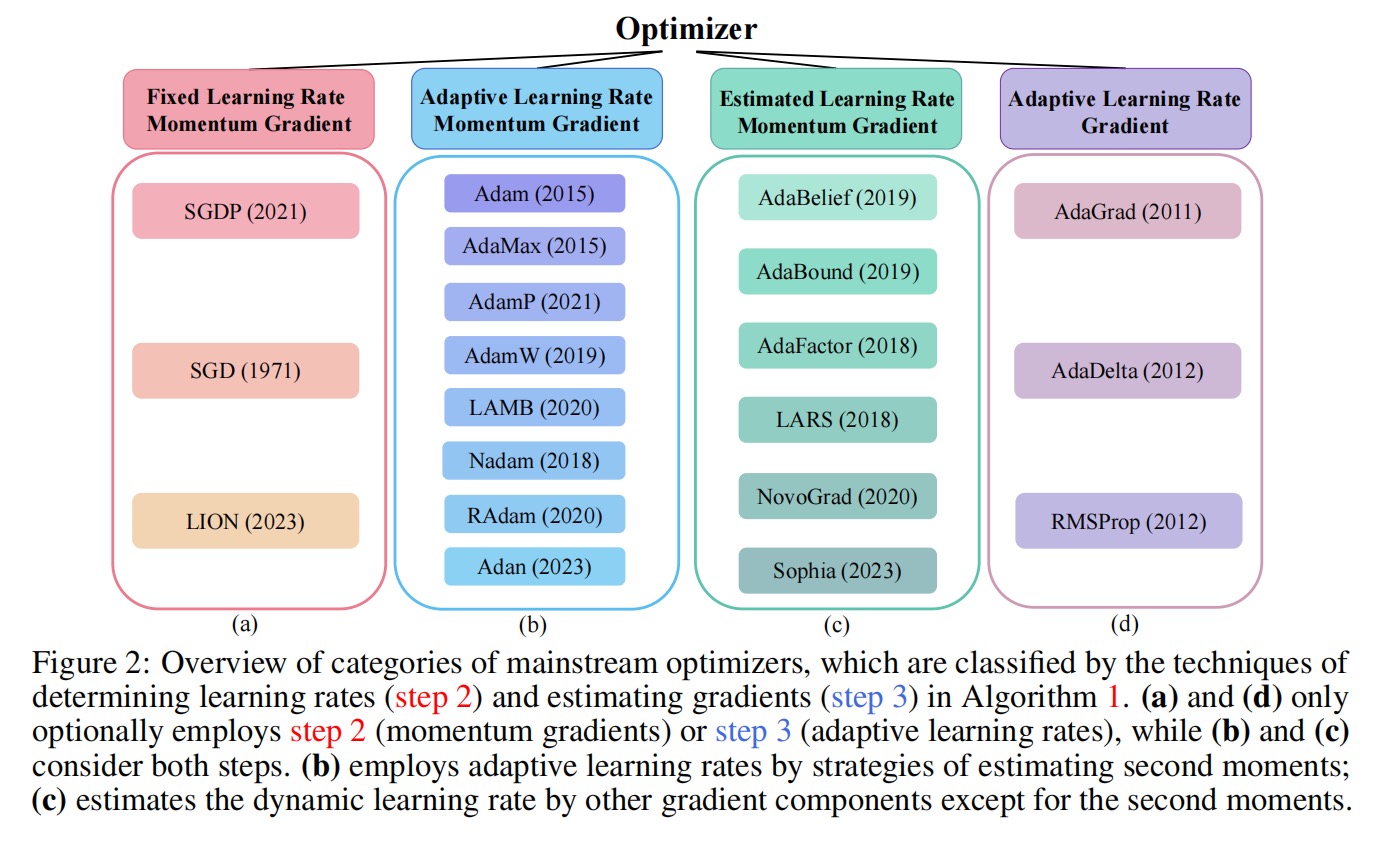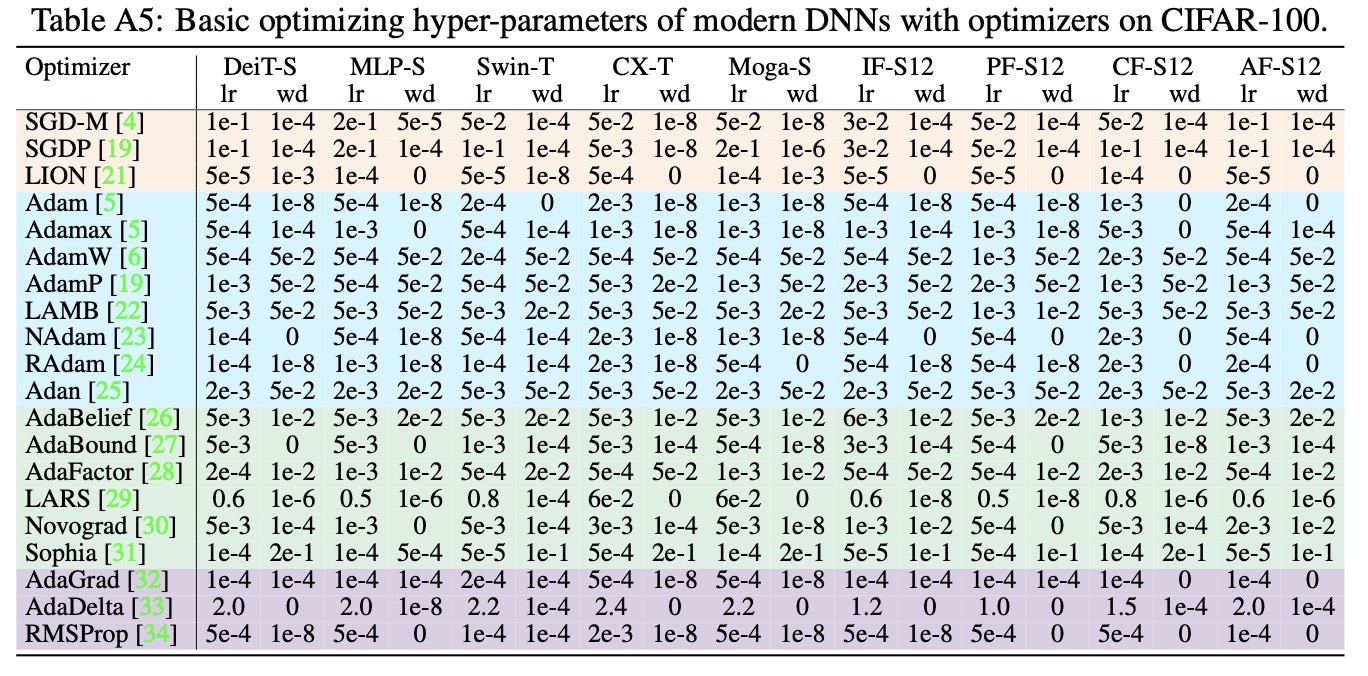Welcome to Awesome Optimizers, a meticulously curated collection of optimization algorithms implemented in PyTorch, designed to serve the diverse needs of the machine learning research community.
If this repository has been helpful to you, please consider giving it a ⭐️ to show your support. Your support helps us reach more researchers and contributes to the growth of this resource. Thank you!
- Introduction
- Awesome Optimizers
- Optimizer Paradigm Definition
- Our Latest Work: A Decade’s Battle on the Bias of Vision Backbone and Optimizer
- Benchmark
- Four categories of optimizers
- Recommended Hyperparameter Settings
- Contribution
In the domain of machine learning, the selection of an appropriate optimizer is of equal significance to the architectural design of the model itself.
I have meticulously assembled a compendium of preeminent optimizers from the recent scholarly landscape, complemented by lucid roadmaps and pedagogical tutorial notebooks. My insights, garnered from active engagement in pertinent projects, further enrich this repository. I warmly welcome contributions to this project, including the latest optimizers, tutorial notebooks, or any other valuable resources that can benefit researchers in our community.
I present a meticulously curated roadmap of optimizers, as depicted in the 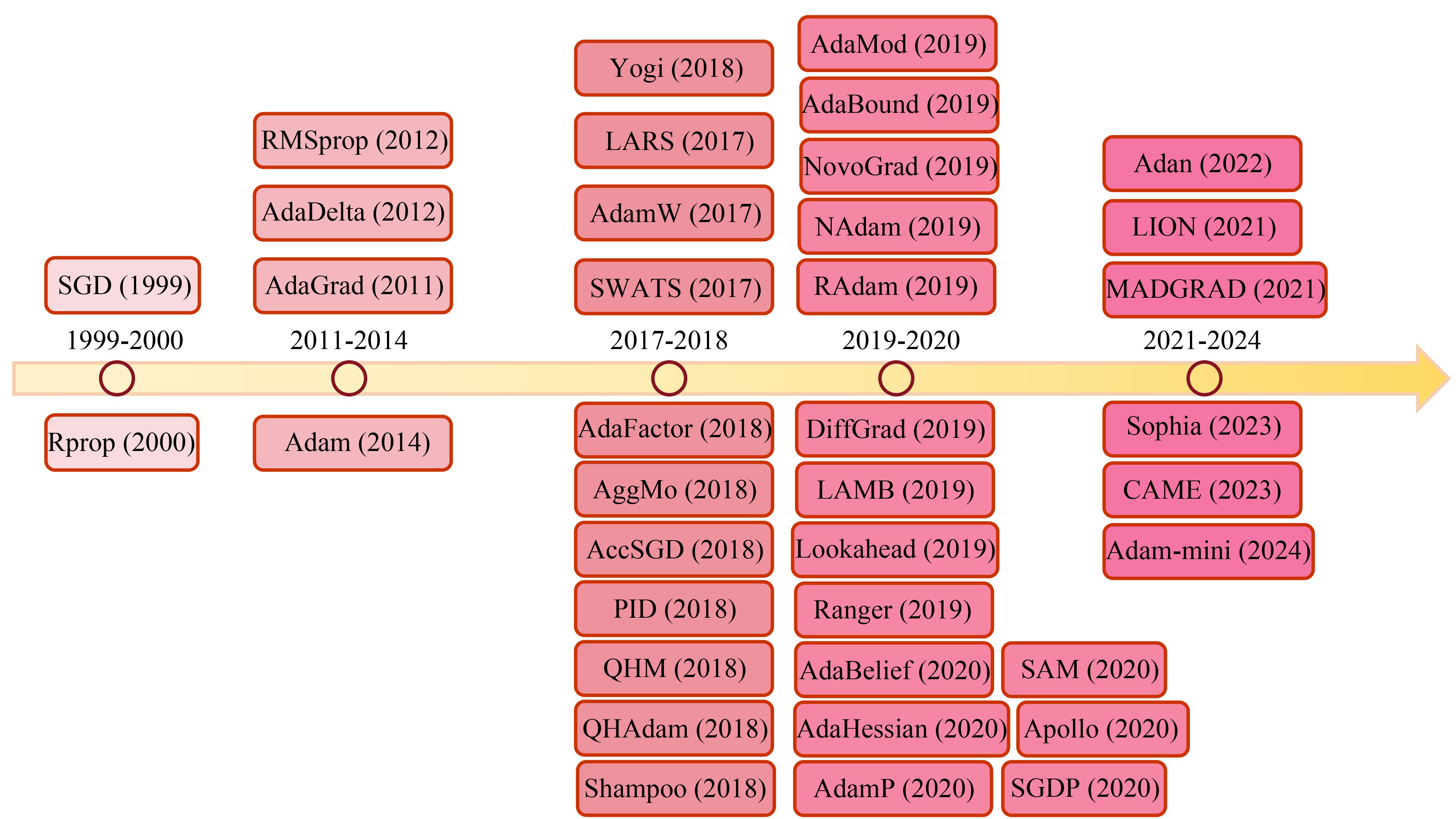
This roadmap is continuously updated to reflect the latest advancements. Should you identify any errors or omissions in this repository, please do not hesitate to open an issue or submit a pull request. Our ongoing survey is in the process of being updated, and this represents the most current iteration.
For those seeking to explore the interconnections among relevant papers, we recommend utilizing Connected Papers, a tool that visualizes the academic landscape through a graph representation. To export a paper's BibTeX citation, consult the paper's arXiv or Semantic Scholar entry for a professionally formatted reference.
Here is a list of some popular optimizers and their corresponding papers:
| Optimizer Name | Paper | Year | Advantages |
|---|---|---|---|
| SGD | On the importance of initialization and momentum in deep learning | 1999 | Simple and effective; foundational for many other optimizers. |
| Rprop | Rprop - A Fast Adaptive Learning Algorithm | 2000 | Adaptive step sizes per parameter; fast convergence for small networks. |
| AdaGrad | Adaptive Subgradient Methods for Online Learning and Stochastic Optimization | 2011 | Adaptive learning rates; effective for sparse data. |
| RMSprop | Lecture 6.5 - rmsprop, COURSERA: Neural Networks for Machine Learning | 2012 | Adaptive learning rates; suitable for non-stationary objectives. |
| AdaDelta | ADADELTA: An Adaptive Learning Rate Method | 2012 | Adaptive learning rates without manual tuning; addresses AdaGrad's diminishing learning rates. |
| Adam | Adam: A Method for Stochastic Optimization | 2014 | Combines best properties of AdaGrad and RMSprop; widely used and effective. |
| LARS | Large Batch Training of Convolutional Networks | 2017 | Enables large batch training with stability; improves training efficiency. |
| AdamW | Decoupled Weight Decay Regularization | 2017 | Fixes weight decay regularization in Adam; improves generalization. |
| SWATS | Improving Generalization Performance by Switching from Adam to SGD | 2017 | Hybrid approach combining Adam and SGD; improves generalization. |
| Shampoo | Shampoo: Preconditioned Stochastic Tensor Optimization | 2018 | Preconditions stochastic tensor optimization; improves convergence. |
| QHAdam | Quasi-hyperbolic momentum and Adam for deep learning | 2018 | Combines quasi-hyperbolic terms with Adam; balances momentum and adaptivity. |
| QHM | Quasi-hyperbolic momentum and Adam for deep learning | 2018 | Introduces quasi-hyperbolic momentum; balances Nesterov momentum and SGD. |
| Yogi | Adaptive Methods for Nonconvex Optimization | 2018 | Improved update rule for adaptive methods; handles nonconvex optimization better. |
| AdaFactor | AdaFactor: Adaptive Learning Rates with Sublinear Memory Cost | 2018 | Reduces memory usage compared to Adam; suitable for large models. |
| AggMo | Aggregated Momentum: Stability Through Passive Damping | 2018 | Uses multiple momentum terms; improves stability and convergence. |
| PID | A PID Controller Approach for Stochastic Optimization of Deep Networks | 2018 | Employs PID control principles; improves convergence and stability. |
| AccSGD | Accelerating Stochastic Gradient Descent via Online Learning to Learn | 2018 | Accelerates SGD by learning to adapt the learning rate online. |
| AdaBound | Adaptive Gradient Methods with Dynamic Bound of Learning Rate | 2019 | Bounds the learning rate dynamically; combines benefits of adaptive and SGD methods. |
| LAMB | Large Batch Optimization for Deep Learning: Training BERT in 76 minutes | 2019 | Enables large batch training for BERT; improves training efficiency. |
| Lookahead | Lookahead Optimizer: k steps forward, 1 step back | 2019 | Combines with other optimizers to improve convergence and stability. |
| RAdam | On the Variance of the Adaptive Learning Rate and Beyond | 2019 | Rectifies variance of the adaptive learning rate; improves stability. |
| AdaMod | AdaMod: An Adaptive Momentum Method for Stochastic Gradient Descent | 2019 | Modulates the momentum term adaptively; improves stability and convergence. |
| Ranger | Ranger: A Hybrid Optimizer for Deep Learning | 2019 | Combines RAdam and Lookahead; improves convergence and generalization. |
| NAdam | Incorporating Nesterov Momentum into Adam | 2019 | Combines Nesterov momentum with Adam; improves convergence. |
| NovoGrad | Stochastic Gradient Methods with Layer-wise Adaptive Moments for Training of Deep Networks | 2019 | Uses layer-wise adaptive moments; efficient for deep networks. |
| DiffGRAD | DiffGrad: An Optimization Method for Convolutional Neural Networks | 2019 | Differentiates the gradient history; improves convergence. |
| Adahessian | ADAHESSIAN: An Adaptive Second Order Optimizer for Machine Learning | 2020 | Uses Hessian information adaptively; suitable for nonconvex optimization. |
| AdaBelief | AdaBelief Optimizer: Adapting Stepsizes by the Belief in Observed Gradients | 2020 | Adapts stepsizes based on the belief in observed gradients; improves convergence. |
| AdamP | Slowing Down the Weight Norm Increase in Momentum-based Optimizers | 2020 | Mitigates weight norm increase; improves generalization. |
| SGDP | Slowing Down the Weight Norm Increase in Momentum-based Optimizers | 2020 | Prevents excessive weight norm increase; improves stability. |
| Apollo | Apollo: An Adaptive Parameter-wise Diagonal Quasi-Newton Method for Nonconvex Stochastic Optimization | 2020 | Adaptive quasi-Newton method; efficient for nonconvex optimization. |
| SAM | Sharpness-Aware Minimization for Efficiently Improving Generalization | 2020 | Minimizes sharpness of the loss landscape; improves generalization. |
| MADGRAD | Adaptive Gradient Methods with Dynamic Bound of Learning Rate | 2021 | Dynamically bounds the learning rate; improves stability. |
| LION | LION: Lévy-inspired Optimizer for Deep Learning | 2021 | Inspired by Lévy flights; explores the loss landscape efficiently. |
| Adan | Adaptive Nesterov Momentum Algorithm for Faster Optimizing Deep Models | 2022 | Adaptive Nesterov momentum; faster optimization for deep models. |
| CAME | CAME: Confidence-guided Adaptive Memory Efficient Optimization | 2023 | Adaptive and memory-efficient; improves optimization with confidence guidance. |
| Sophia | Sophia: A Scalable Stochastic Second-order Optimizer for Language Model Pre-training | 2023 | Scalable second-order optimizer; efficient for large-scale pre-training. |
| Adam-mini | Adam-mini: Use Fewer Learning Rates To Gain More | 2024 | Reduces the number of learning rates; simplifies hyperparameter tuning. |
Click to Expand
Algorithm: General Algorithm of Optimizer for DNNs
Input:
- DNN parameters
$\theta = {\theta_l}_{l=1}^{L}$ - Initial learning rate
$\text{lr}$ - Weight decays
$\omega = {\omega_l}_{l=1}^{L}$ - Loss function
$\mathcal{L}$ - Dataset
$\mathcal{D}$
Initialization:
- Parameters
$\theta^{0} = {\theta_{l}^{0}}_{l=1}^{L}$ - Learning rates
${\alpha_i^0}_{l=1}^{L} \leftarrow \text{lr}$
Procedure:
Click to Expand
Siyuan Li*,1,2, Juanxi Tian*,1, Zedong Wang*,1, Luyuan Zhang1, Zicheng Liu1, Chen Tan1, Weiyang Jin1, Lei Xin1, Yang Liu2, Baigui Sun2, Stan Z. Li†,1
Abstract The past decade has witnessed rapid progress in vision backbones and an evolution of deep optimizers from SGD to Adam variants. This paper, for the first time, delves into the relationship between vision network design and optimizer selection. We conduct comprehensive benchmarking studies on mainstream vision backbones and widely-used optimizers, revealing an intriguing phenomenon termed backbone-optimizer coupling bias (BOCB). Notably, classical ConvNets, such as VGG and ResNet, exhibit a marked co-dependency with SGD, while modern architectures, including ViTs and ConvNeXt, demonstrate a strong coupling with optimizers with adaptive learning rates like AdamW. More importantly, we uncover the adverse impacts of BOCB on popular backbones in real-world practice, such as additional tuning time and resource overhead, which indicates the remaining challenges and even potential risks. Through in-depth analysis and apples-to-apples comparisons, however, we surprisingly observe that specific types of network architecture can significantly mitigate BOCB, which might serve as promising guidelines for future backbone design. We hope this work as a kick-start can inspire the community to further question the long-held assumptions on vision backbones and optimizers, consider BOCB in future studies, and thus contribute to more robust, efficient, and effective vision systems. It is time to go beyond those usual choices and confront the elephant in the room. The source code and models are publicly available.
Backbone-Optimizer Coupling Bias (BOCB) is a phenomenon we observed during the bench-marking, which arises from the intricate interplay between the design principles of vision backbones and the inherent properties of optimizers.
Click to Expand
To illustrate the performance differences of 20 optimizers across various vision backbones under optimal parameter settings, we have included the figure 
and
These figures provides clear visual representation of how different optimizers perform in different scenarios.
In LMFlow, I have contributed a customizable optimization fine-tuning feature, enabling you to freely select an optimizer for testing, with the intention to incorporate additional optimization techniques in forthcoming updates.
custom_optimizers
Below is a comprehensive Benchmark table detailing the fine-tuning of GPT2 with various optimizers on the alpaca dataset (The default hyperparameter setting is num_epoch=0.1. For reference only.).
| Optimizer Name | Train Loss |
|---|---|
| RMSprop | 2.4016 |
| LION-32bit | 2.4041 |
| Adam | 2.4292 |
| AdamP | 2.4295 |
| AdamW | 2.4469 |
| AdaFactor | 2.4543 |
| AdaBound | 2.4547 |
| AdamWScheduleFree | 2.4677 |
| Adan | 2.5063 |
| NAdam | 2.5569 |
| AdaBelief | 2.5857 |
| AdaMax | 2.5924 |
| RAdam | 2.6104 |
| AdaDelta | 2.6298 |
| AdaGrad | 2.8657 |
| Yogi | 2.9314 |
| NovoGrad | 3.1071 |
| Sophia | 3.1517 |
| LAMB | 3.2350 |
| LARS | 3.3329 |
| SGDScheduleFree | 3.3541 |
| SGDP | 3.3567 |
| SGD | 3.3734 |
Click to Expand
I have categorized classic optimizers into four main types, as shown in the following image:
This classification helps in understanding the underlying principles and applications of these optimizers.
Click to Expand
Herein, we present a set of recommended hyperparameters for use under various visual backbone scenarios. Please note that these suggestions are based on extensive research and empirical findings, and should be considered a useful starting point rather than a one-size-fits-all solution. As with any machine learning application, the optimal hyperparameters may vary depending on the specific characteristics of your dataset and the computational resources available to you. We encourage practitioners to use these recommendations as a foundation and to further fine-tune them to suit their unique requirements and constraints.
The main maintainer is Juanxi Tian (@Juanxi Tian).
Future contributors are welcome, and feel free to send pull requests in hopes that Awesome-Optimizers can become a more mature toolbox in the machine learning community.



